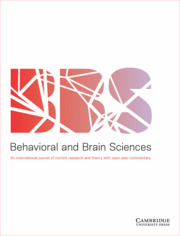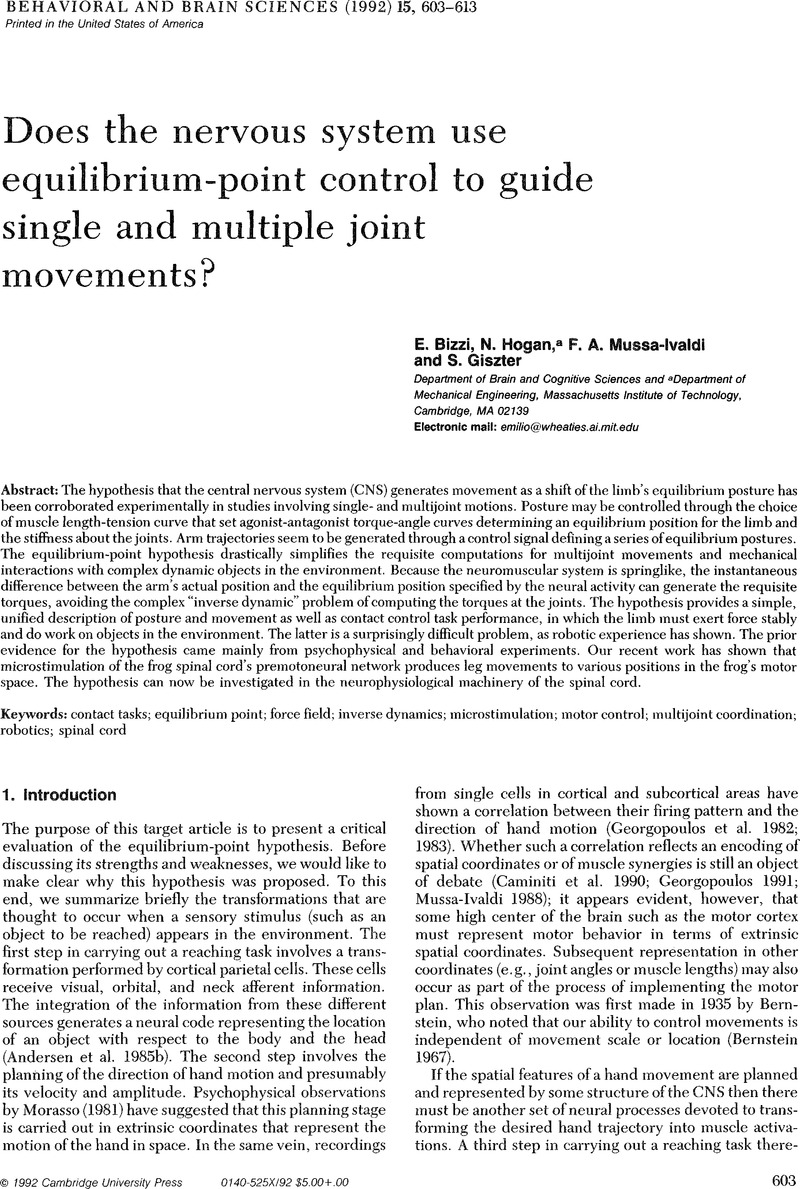Crossref Citations
This article has been cited by the following publications. This list is generated based on data provided by Crossref.
Thelen, Esther
1995.
Origins of origins of motor control.
Behavioral and Brain Sciences,
Vol. 18,
Issue. 4,
p.
780.
Windhorst, U.
1995.
Levers to generate movement.
Behavioral and Brain Sciences,
Vol. 18,
Issue. 4,
p.
784.
Sternad, Dagmar
and
Turvey, M. T.
1995.
Control parameters, equilibria, and coordination dynamics.
Behavioral and Brain Sciences,
Vol. 18,
Issue. 4,
p.
780.
Wright, Charles E.
and
States, Rebecca A.
1995.
Biological variability and control of movements via δλ.
Behavioral and Brain Sciences,
Vol. 18,
Issue. 4,
p.
786.
Lestienne, F.
Ghafouri, M.
and
Thullier, F.
1995.
What does body configuration in microgravity tell us about the contribution of intra- and extrapersonal frames of reference for motor control?.
Behavioral and Brain Sciences,
Vol. 18,
Issue. 4,
p.
766.
Hodgson, Antony
1995.
The unobservability of central commands: Why testing hypotheses is so difficult.
Behavioral and Brain Sciences,
Vol. 18,
Issue. 4,
p.
763.
Fikes, Thomas G.
and
Townsend, James T.
1995.
Moving models of motion forward: Explication and a new concept.
Behavioral and Brain Sciences,
Vol. 18,
Issue. 4,
p.
751.
Levin, Mindy F.
and
Feldman, Anatol G.
1995.
The λ model for motor control: More than meets the eye.
Behavioral and Brain Sciences,
Vol. 18,
Issue. 4,
p.
786.
Smeets, Jeroen B. J.
1995.
Two joints are more than twice one joint.
Behavioral and Brain Sciences,
Vol. 18,
Issue. 4,
p.
779.
Winters, Jack M.
1995.
How far should we extend the equilibrium point (lambda) hypothesis?.
Behavioral and Brain Sciences,
Vol. 18,
Issue. 4,
p.
785.
Gottlieb, Gerald L.
1995.
Shifting frames of reference but the same old point of view.
Behavioral and Brain Sciences,
Vol. 18,
Issue. 4,
p.
758.
Patla, Aftab E.
1995.
The λ model: Can it walk?.
Behavioral and Brain Sciences,
Vol. 18,
Issue. 4,
p.
775.
lngvaldsen, R.
and
Whiting, H.T.A.
1995.
Frameworks on shifting sands.
Behavioral and Brain Sciences,
Vol. 18,
Issue. 4,
p.
764.
Fidelman, Uri
1995.
The lambda model and a hemispheric motor model of intentional hand movements.
Behavioral and Brain Sciences,
Vol. 18,
Issue. 4,
p.
750.
Pagano, Christopher C.
and
Bingham, Geoffrey P.
1995.
Spatial frames for motor control would be commensurate with spatial frames for vision and proprioception, but what about control of energy flows?.
Behavioral and Brain Sciences,
Vol. 18,
Issue. 4,
p.
773.
Feldman, Anatol G.
and
Levin, Mindy F.
1995.
The origin and use of positional frames of reference in motor control.
Behavioral and Brain Sciences,
Vol. 18,
Issue. 4,
p.
723.
Dean, Jeffrey
1995.
The lambda model is only one piece in the motor control puzzle.
Behavioral and Brain Sciences,
Vol. 18,
Issue. 4,
p.
749.
Gielen, C. C. A. M.
and
van Bolhuis, B.
1995.
Reciprocal and coactivation commands are not sufficient to describe muscle activation patterns.
Behavioral and Brain Sciences,
Vol. 18,
Issue. 4,
p.
754.
Kay, Bruce A.
1995.
Frames of reference interact and are task-dependent.
Behavioral and Brain Sciences,
Vol. 18,
Issue. 4,
p.
765.
Nichols, T. Richard
1995.
Interneurons as backseat drivers and the elusive control variable.
Behavioral and Brain Sciences,
Vol. 18,
Issue. 4,
p.
772.


